- Off The Beaten Trail!
- Posts
- From Off the Beaten Path to Off the Beaten Trail
From Off the Beaten Path to Off the Beaten Trail
...or, how do I find all of these places?
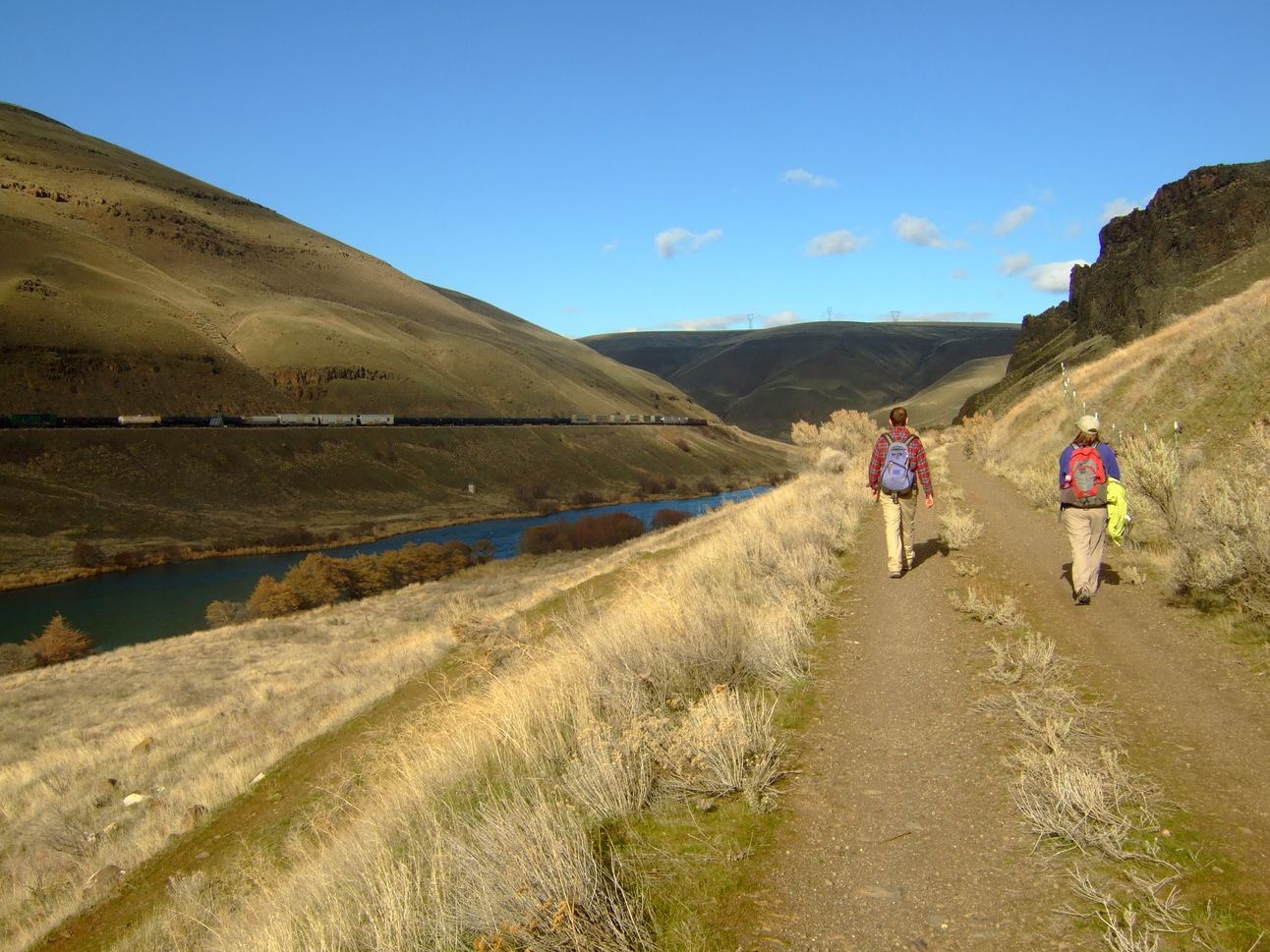
For whatever reason lately, I’ve been thinking about one of my favorite hikes that I’ve ever done. It was in a most improbable place: on an island off the western coast of Ireland, with a good friend that I haven’t seen since because we haven’t been in the same place at the same time. It was her idea, and as such we took a ferry from her hometown of Westport out to the island. Once we were there, we hiked from the dock up to sea cliffs overlooking the bay, and somewhere out there, the Atlantic Ocean:
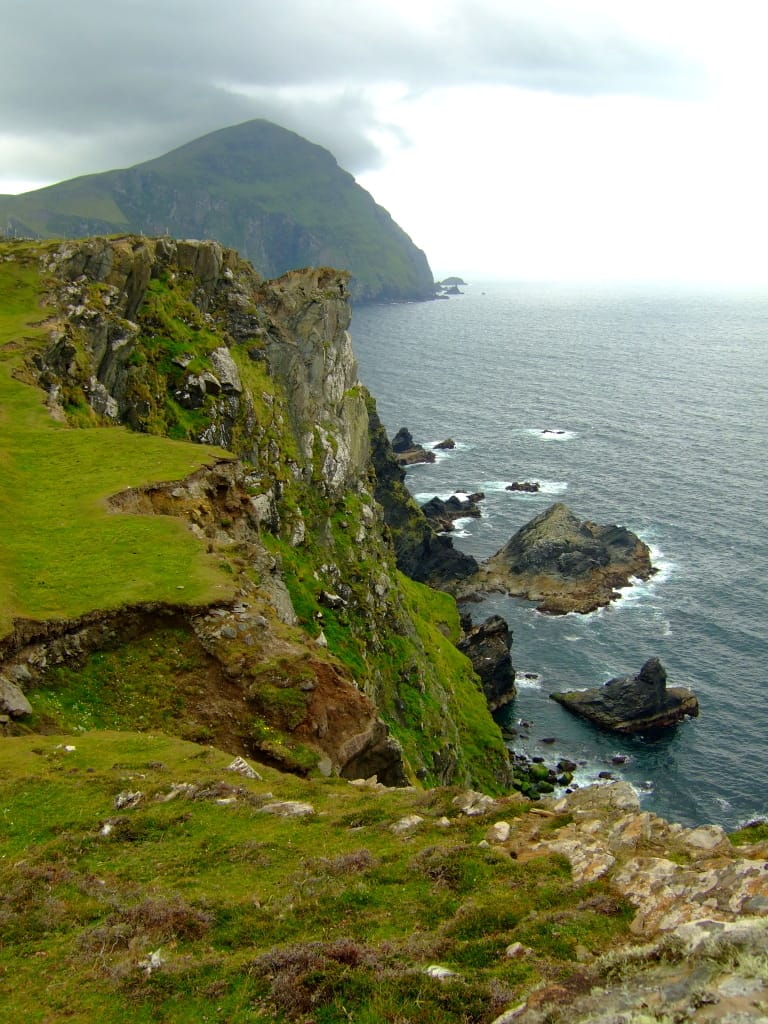
Irish sea cliffs! This was one of my favorite hikes ever.
It was a wonderful day that I still think about sometimes, 17 years later. It is a place I would have never thought of visiting had I not already been there, with a good friend who knew where to go.
If you want to know where to go, ask a local (or even better yet, have a badass Irish friend take you somewhere you never would have gone otherwise). This is how it always used to be. It still is in many ways, but now we have this thing called the internet. Many humans these days will look up where to go hiking or camping or snowboarding or whatever, and follow the lists that the internet gives them without a second thought. I probably would not have done this hike were it not for my friend, and I’ll never forget it.
But obviously we have to start somewhere, right? And now, more than ever in this age of government cutbacks, surging crowds of tourists, and the general feeling of despair that permeates the globe (and especially the United States), we will need our ingenuity to figure how to get away from all of this madness.
If you’re reading this, then you probably already know that I am an expert at finding interesting places that are little-known or seldom-traveled.
This is where my journey started:
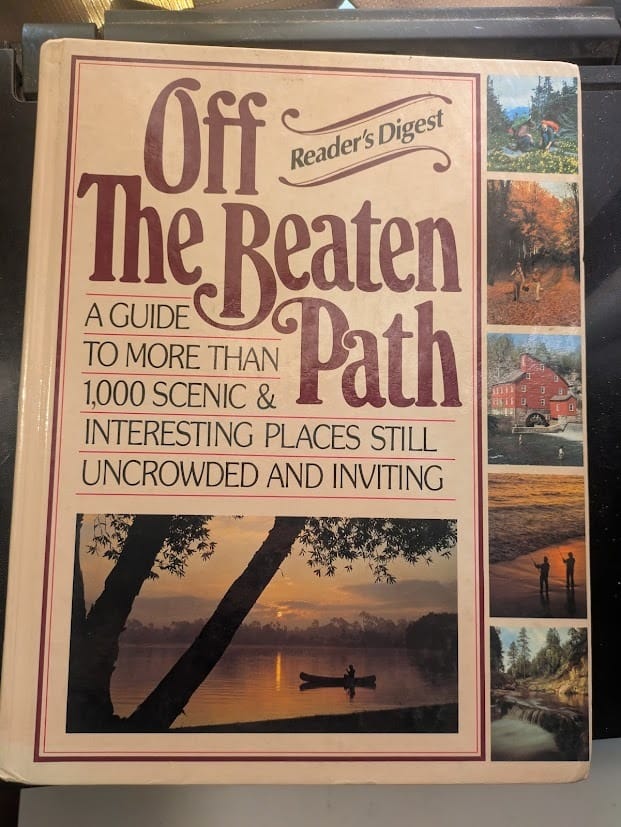
Off the Beaten Path, a guide to random and interesting places in the US.
Knowing how much I loved geography, my grandmother bought me this book when I was 8 or 9. We had moved to Oregon only a couple of years before, and I was eager to explore more of our new state. The book proved to be an excellent find, and I read through the book several times. I recently found a copy of this book at a thrift store here in Portland (the copy in the picture), and I bought it for my buddy Keith. He loves finding random places, and I am glad I could give him a copy. I think he liked it. This book holds up; I flipped through it the other night and found lots of cool places I’ve been, and others I’d like to visit. If you’re interesting in owning a copy (beware, it’s huge, like a coffee table book), there are tons of copies available for cheap on eBay.
ANYWAY, looking through this book reminded me how I got started looking for some of the random and obscure places I know and love. Off the Beaten Path was the first book I owned that got me going. The second was this classic:
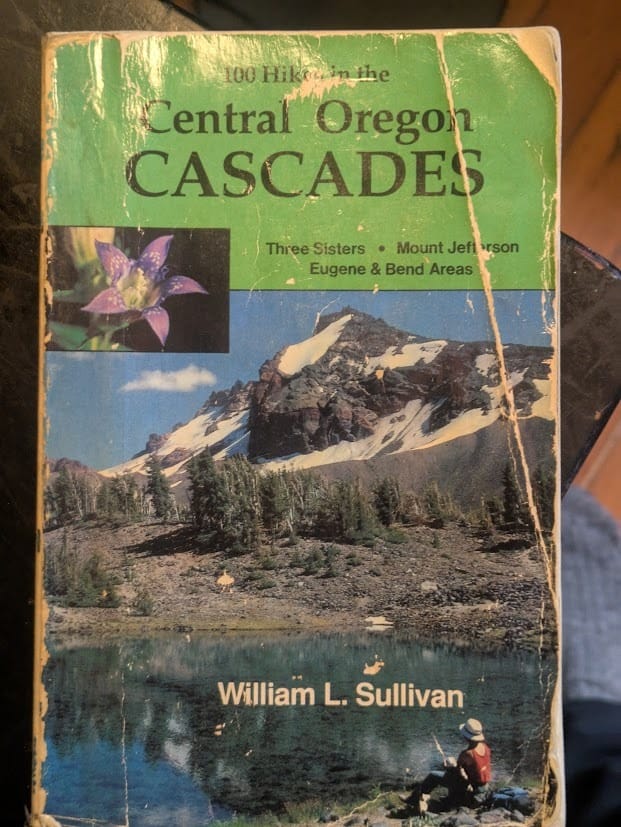
The very first edition of the famed Sullivan Central Oregon guidebook.
For those of you not in Oregon, William L. Sullivan is a famed guidebook author based out of Eugene, Oregon. He hiked across Oregon from its southwest tip to its northeast corner, an adventure he recounted in his 1988 book Listening For Coyote. When I was 9, my stepdad and I attended Sullivan’s talk at the Salem Public Library, and afterwards we bought his guidebook, which he signed for us. This is the copy you see in the picture above is that copy, 34 years and a lot of love later. We used this book religiously to explore the mountains east of Salem, and we soon bought a few other guidebooks and topographic maps to help us plan our adventures out more. Before long, my stepdad put me in charge of adventure planning, since I was so good at it and since I also had a taste for more obscure adventures and for avoiding crowds. Of course, this was the 90s, so the crowds were not like they are now. Here’s a photo of me from the 90s, when it was easy to get away and hiking to even popular places were not crowded:
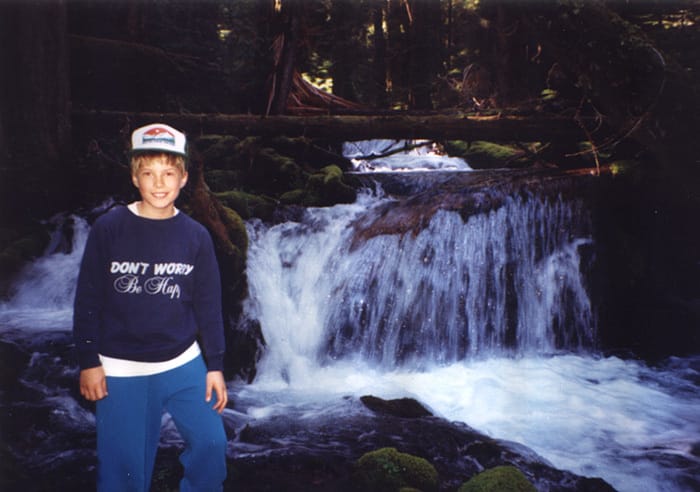
Me at Pamelia Creek, June 1991.
Geez, I was such a dork.
After 9 years in Oregon, we moved back to Illinois to help take care of our extended families. Even then I tried to find places for us to explore, and I did succeed to an extent. Illinois is a much prettier place than even more people in Illinois realize, and I fell in love with Sand Ridge State Forest south of Peoria. I’ll write more about that some other time, because it’s a fun place and because scenic beauty in Illinois is well worth a post on its own.
When I was studying French in college, I signed up for a program to study in France in 2002. It was advertised as a summer in the Alps. The flier specifically mentioned “Spend your summer hiking in the Alps!” - so that is what I intended to do. It took a lot of financial planning to get me onto this program, which was an overview of France. The trip started in Paris, spent a week visiting every monument you could possibly imagine there, then spent four days in the Loire Valley visiting châteaux and Mont-Saint-Michel. But the real heart of the trip was a month in Grenoble, where we would all study by morning, and fill our afternoons with whatever we wanted. For many in our group, that was sitting around doing nothing. For some it was summer flings. Me? I spent the summer doing exactly what I had intended on doing: hiking in the Alps.
I hadn’t been hiking much since I moved back to Illinois, other than the occasional trip to Sand Ridge. But I immediately sought out the best way to explore the mountains surrounding beautiful Grenoble. So I did what I’d always done: I bought a guidebook:
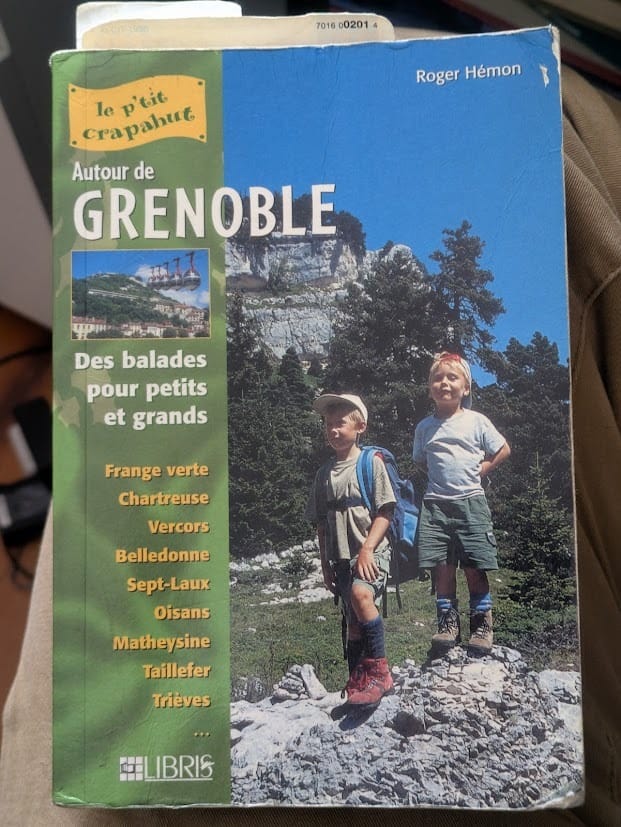
As proof that you can find anything on eBay, I found a few copies there too. So I spent the summer exploring, and I had many adventures. Here is a video of me telling a story about that summer, from a story telling event that I did in Salem in 2019:
That summer changed my life. I rediscovered my love and passion for hiking, and by the end of the summer I knew two things: 1) that I would return to France, and 2) that I would move back to Oregon when I was done with college. Here’s a photo from my last day in Grenoble, as I visited my favorite hike (Les Gorges du Furon) one last time:
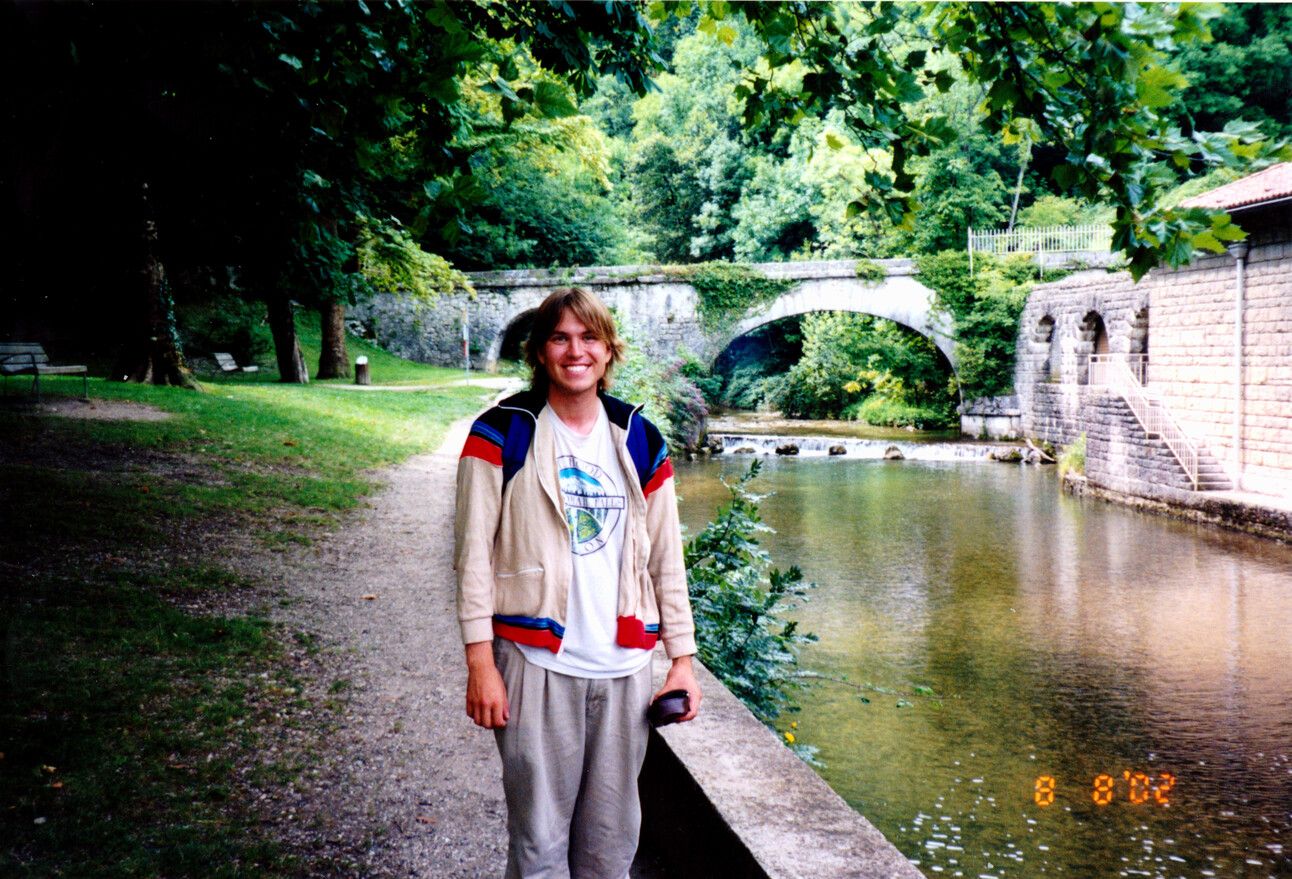
Me at the entrance to the Gorges du Furon, August 2002.
Three years later, I found myself back in Oregon, in graduate school and yet with a taste for adventure. So that’s where this really begins.
How do I plan adventures? Where do I find these places? Whenever I do a presentation, or whenever I lead a hike for the Mazamas, these are two of the questions people ask me most frequently.
It starts with my guidebook collection. If you’ve made it this far into this post, you will not be surprised to learn that I have approximately 60 guidebooks in my collection (plus the four that I wrote). This is after downsizing last year; I gave away about 20 when I led my last AYM hike in April. In this day and age however, most people don’t want to cart around dozens of guidebooks, many of which have overlapping information, most of which are obsolete within 5 years of publication. I am sympathetic to folks who do not need to own lots of guidebooks and would prefer to find their information elsewhere. This is the existential question at the heart of my writing career, and a question that I am honestly not sure how to answer anymore.
In the absence of owning guidebooks, most people use the internet, and more specifically, AllTrails. You might have noticed that my link to the Gorges du Furon hike above was an AllTrails link - I was amazed to learn that AllTrails exists in France too. Why wouldn’t it? It’s an app, and it does not need to be linked to a particular place.
It will not be surprising to learn that the rise of AllTrails has meant the fall of sales of guidebooks. Many people have suggested to me that I create an app to hold all of my hiking knowledge, from my guidebooks to my other adventures. Needless to say, creating an app is far beyond my technical abilities, and I am not sure who would even buy it beyond the people who already buy my guidebooks. I am instead rebuilding my website with a lot of hikes, travel suggestions, and blog posts, which I hope to relaunch next month at some point.
But enough of my whining. Many of you already use AllTrails, and I’m not going to tell you that you shouldn’t. It is a useful tool to learn about current conditions in places, and to help plan adventures when you travel. Even I, the guidebook author, have it installed on my phone - though it is often my last resort, not my first.
The rise of AllTrails has also accompanied the rise of social media, and the rise of clickbait sites and endless Top 10 lists has also meant that some hikes are now so crowded that they just aren’t fun anymore. I’m not going to call out any specific site or social media account - we’re all just trying to have fun here! But finding the fun and obscure places to go has become far more difficult for most people. For example: I remember first hearing about the Enchantments about 15 years ago, and how you needed a permit to visit. It sounded really cool, yet another cool place to visit in the Washington Cascades.
Thanks to social media sharing photos of the Enchantments and the exclusivity of the permit system, visiting the Enchantments is now an exercise in frustration, FOMO, and truly mind-boggling hyperbole. For example: the Oregon Hikers Field Guide entry for the Enchantments lists it as the “Most Spectacular hike on Earth”. While it is no doubt beautiful (and no, I haven’t been, for reasons that should already be obvious), hyperbole like this is leading people to have full-on tantrums on social media when they don’t get a permit to backpack in the area. It is also leading people to make Colchuck Lake (one of the primary entrances to the Enchantments, and which does not require a permit to hike in a day) so popular that cars line the road for as much as mile before the trailhead in the summer. Such insane popularity is not making the place more appealing for me, nor is it doing anything for the ecosystem other than turning it into a glorified city park with better scenery. It is also worth noting that there are many other similarly beautiful places in that part of Washington, and most of them don’t require mile-long lines of cars and super-restrictive permits to visit. Here’s a tarn on the side of Mount Baker in the North Cascades, which Wendy and I had to ourselves other than a herd of mountain goats:
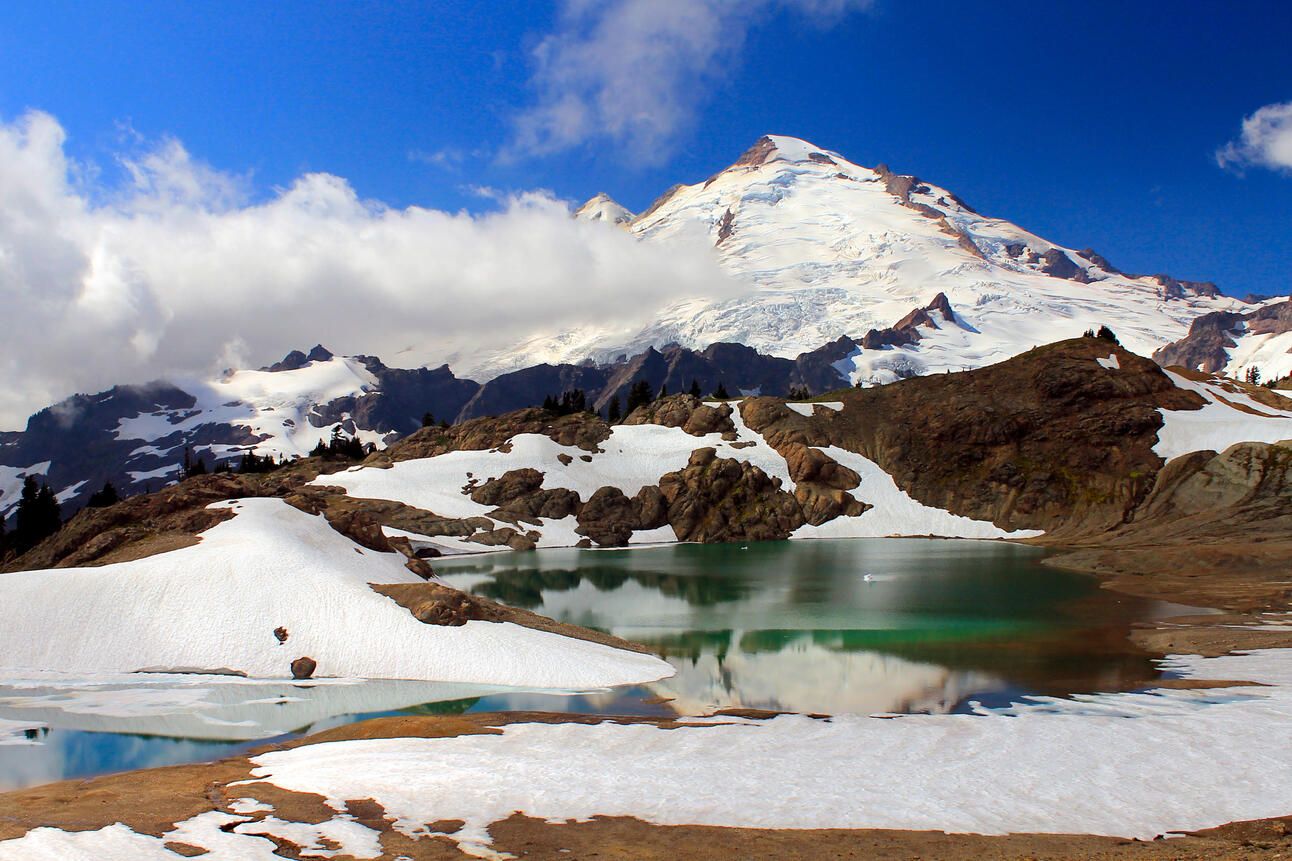
Mount Baker and a glacial tarn, September 2018.
So how do we do better? It starts with acknowledging that a connection to nature is a large part of why we go outside. A place like Colchuck Lake is special, but the crowds take away a large part of this for me at least. I remember the one time that I hiked to Lake Serene in Washington, the trail was so crowded that we literally saw people every thirty seconds. The hike was beautiful, of course, but it was so crowded that I have zero desire to ever go back. There are so many beautiful places in the Cascades in Washington that I’m never going to subject myself to huge crowds when I have many other uncrowded places I could visit instead.
When I look for hikes now, the possibility of solitude is every bit as important as how beautiful it is. There are a lot of beautiful places out there, and most of them are not crowded, no matter where you are. So how to find them?
The first step is to plan your own adventure rather than let others, whether it be influencers, the algorithms, Google, or even AI, plan it for you. Figure out for yourself what sounds like fun, and be willing to venture outside of your comfort zone. You made the decision after all; let go of the FOMO and embrace it.
I like to start planning an adventure by considering what I want to see, how much effort it will take to see it, and when I want to go. So for planning on a day hike during a weekend, I think about the weather and plan around what will be open. It is cold and rainy here for most of the winter, so I plan around the conditions. The mountains are buried in snow from November to June, or even July. I’m not a huge fan of snow travel, be it snowshoeing or skiing, so I take the winter months to hike trails in the Columbia River Gorge or Silver Falls, trails that are far more crowded in the warmer months. They are close, the waterfalls flow much better in the winter, and they aren’t nearly as crowded. When I get tired of the rain in January or February, I start looking for the nearest place I can find sunshine. Contrary to popular belief, only the western third of both Oregon and Washington are rainy; it is usually possible to drive to the rain shadow and find a sunny hike somewhere if I don’t mind a little extra travel time. The added benefit of the rain shadow is that most people live on the rainy side of the mountains, so most of the hikes out there are blissfully free of crowds.
One of my favorites is the trail along the Deschutes River east of The Dalles. I’ve done this hike many times, and I never get tired of it. Here is a photo from the first time I hiked this trail in January 2010:
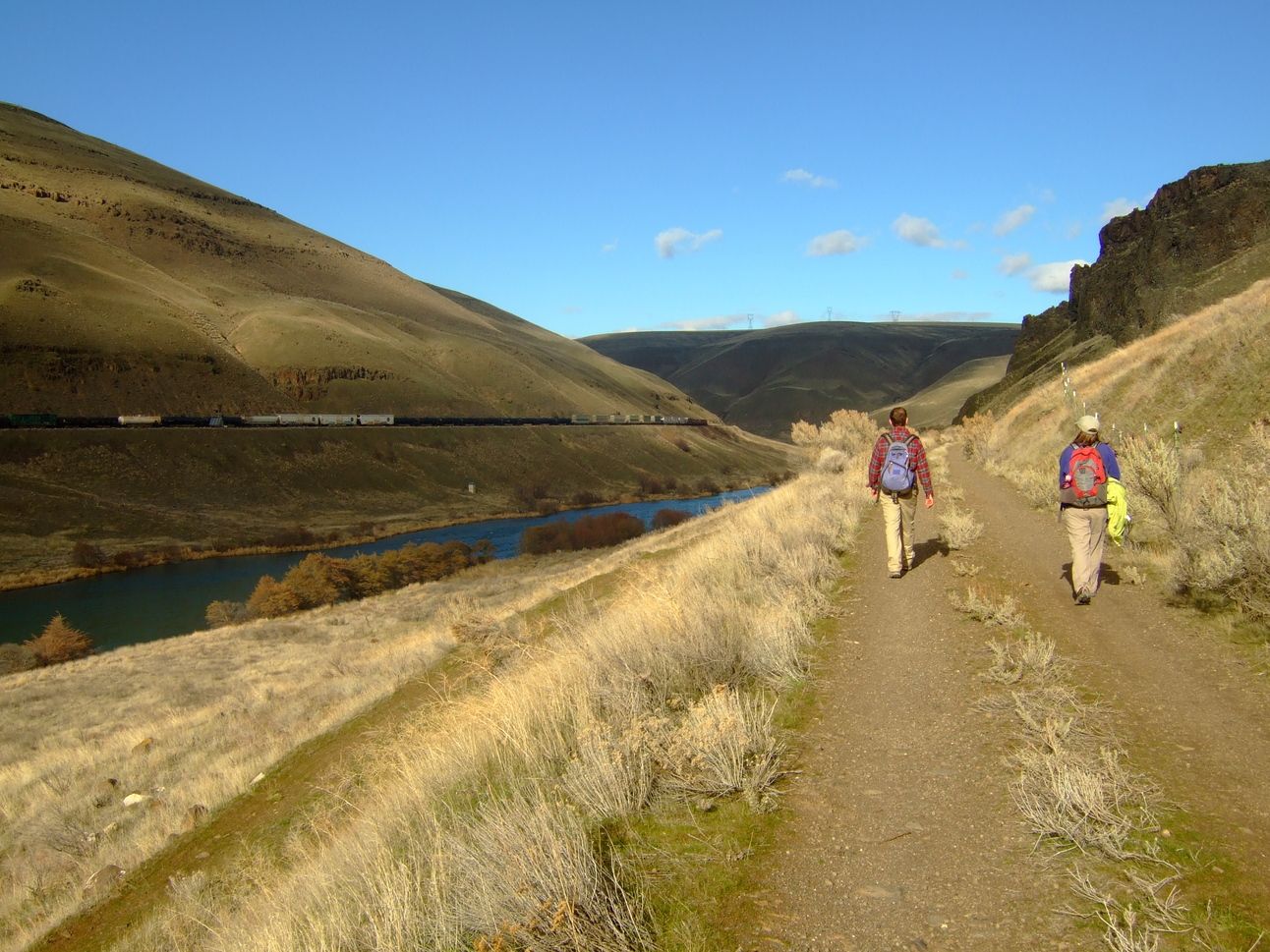
Hiking the Deschutes River Trail, January 2010
It was 48 degrees (9C) and raining when we left Portland that day, but by the afternoon it was 65 degrees (18C) and sunny along the Deschutes. I was hooked, and I’ve been going back ever since. I just don’t go there in the summer when it’s 95 degrees (35C) or even hotter every day.
When the days get longer and Spring begins springing, Wendy and I love to go look for wildflowers. While some of our favorite wildflower hikes have become very popular over the years (such as The Dalles Mountain Ranch), there are many places that remain quiet. They just require more effort to visit. One such place is Sevenmile Hill, one of the most spectacular places in the Columbia River Gorge.
If you’ve noticed that I continue linking to the Oregon Hikers Field Guide, it is because it is the most comprehensive place to find Oregon hiking information on the internet. The Field Guide is the first place I go to find information because it has a vast wealth of hikes, from the extremely crowded to the extremely obscure. There is such a wealth of information there (some of which I have contributed to, and some of which is sourced from my guidebooks - but there is so, so, so much more) that spending time looking through the hikes available can be daunting for anyone who doesn’t want to spend hours looking for the right hike or backpacking trip.
This of course brings us back to being able to find places without having to sift through hundreds of pages to find that hike that is just right - which of course is why people, myself included, use AllTrails even if it’s pretty much the Amazon of the hiking world.
There is one weird trick after all that will help you find what you want: have an open mind and be willing to spend more time looking for places than a quick web search. Some of my favorite hikes I’ve ever done have been places that I did not originally intend to visit, or places that were not featured online in a million and one social media posts and travel websites. One of my favorite examples of this was Wild Cheat Meadow in the Mount Jefferson Wilderness. This was a beautiful hike through ancient forest to a huge meadow full of wildflowers, and then up onto a ridge with huge views of Mount Jefferson. Here’s a photo that Wendy took of me the first time we did this hike:
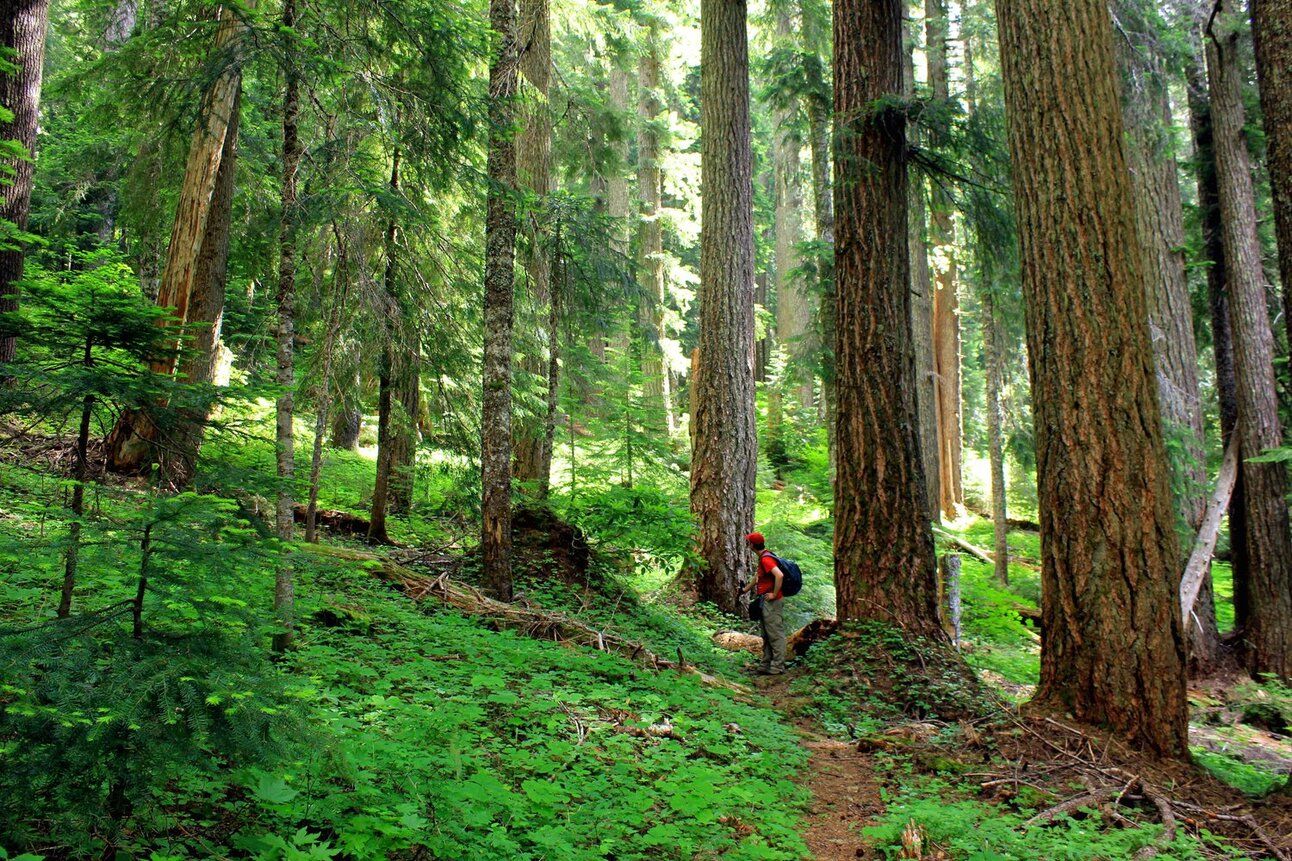
On the Cheat Creek Trail, July 2012
This hike became one of my absolute favorites, but it is currently closed due to fire damage from the 2020 Lionshead Fire. There are plenty of other amazing places that are similarly beautiful, many of them unburned and as beautiful as ever, waiting for you to find. But it requires looking for them yourself, rather than letting an app or social media tell you where to go. Use the apps and social media for inspiration - but then do your research (and not just a quick Google search) with an open mind, waiting to be inspired or follow your muse wherever it will take you. Sometimes you just have to visit a place (especially when you’re on vacation), but most of the time it’s best to reflect on what you want to do and what experience you want to have before you leave home. And of course, sometimes you just need to go see a place because it’s there. That basic idea was how I ended up writing 101 Hikes in the Majestic Mount Jefferson Region.
I know that this will be obvious to many of you reading this, but that’s how I find all these wonderful places. This is also the basic philosophy that forms the backbone of my guidebooks. I’ll be glad to elaborate on all of this more, but I’m over 3,000 words so it’s perhaps best to save this for a future post.
Thanks for reading, and I’ll see you on the trails soon!
Matt